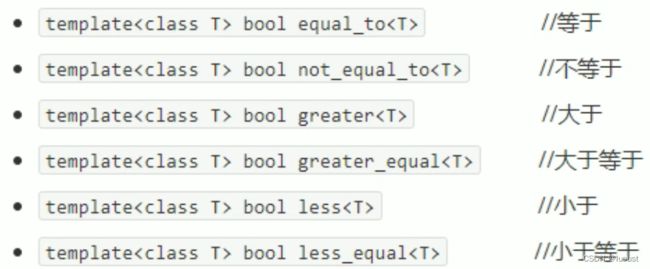c++函数对象(仿函数)、谓词、内建函数对象
1、函数对象
1.1 概念
重载函数调用操作符的类,这个类的对象就是函数对象,在使用这个函数对象对应使用重载的()符号时,行为类似于函数调用,因此这个函数也叫仿函数。
注意:函数对象(仿函数)是一个类,不是函数。
特点:
a)函数对象可以传入参数、返回值。
b)可以使用类的成员参数记录函数对象的状态。
c)函数对象可以作为参数传递。
1.2 示例
特点a、b使用:
//创建一个函数对象,
class Print {
public:
void operator()(string &tex) {
cout << tex << endl;
pNum++;
}
int pNum{};
};
int main() {
string word{ "speak sth!" };
Print print;
print(word);
print(word);
print(word);
print(word);
cout << "" << print.pNum << endl;;
system("pause");
return 0;
}特点c:
class mData {
public:
mData(int x,float y) {
this->mX = x;
this->mY = y;
}
~mData(){}
int mX{};
float mY{};
};
class Sort {
public:
bool operator()(mData& md1, mData& md2) {
return md1.mX > md2.mX;
}
};
void func(mData& md1, mData& md2) {
Sort st;
if (st(md1, md2)) {
cout << " a > b" << endl;
}
else {
cout << " a < b" << endl;
}
}
int main() {
vector vP{};
vP.push_back(mData(1, 2.));
vP.push_back(mData(4, 12.));
func(vP[0], vP[1]);
system("pause");
return 0;
} 2、谓词
2.1 概念
返回bool类型的仿函数为谓词,()内有一个参数为一元谓词、有两个参数为二元谓词。
2.2示例
一元谓词:
//一元谓词创建:一元谓词bool返回值,一个传入参数
class findPass7 {
public:
bool operator()(int val) {
return val > 5;
}
};
int main() {
vector v1;
for (int i = 0; i < 10; ++i) {
v1.push_back(i);
}
vector::iterator iter = find_if(v1.begin(), v1.end(), findPass7());
if (iter != v1.end()) {
cout << "找到5,位于:" << (*iter) << endl;
}
else {
cout << "没找到"<< endl;
}
system("pause");
return 0;
} 注:如果想在stl中使用自定义的数据,类型,首先看这个函数有没有相关的重载,如下函数最右边的 _Pred。
使用二元谓词实现对自定义类的成员参数排序:
class Person {
public:
Person(int age, int length) {
this->mAge = age;
this->mLength = length;
}
int mAge;
int mLength;
};
class getAgeMid {
public:
bool operator()(Person& p1, Person& p2) {
return p1.mAge > p2.mAge;
}
};
int main() {
vector Ps;
Ps.push_back(Person(10,23));
Ps.push_back(Person(20, 33));
Ps.push_back(Person(50, 13));
Ps.push_back(Person(40, 53));
Ps.push_back(Person(30, 73));
sort(Ps.begin(), Ps.end(), getAgeMid());
for (vector::iterator iter = Ps.begin(); iter != Ps.end(); iter++) {
cout << (*iter).mAge << " ";
}
cout << endl;
system("pause");
return 0;
} 3、stl内建函数对象
3.1 分类与用法
算术仿函数、关系仿函数、逻辑仿函数。
引入头文件 : #include
即可使用
3.2 算术仿函数
功能:实现四则运算,negate是一元运算,其余都为二元运算。
仿函数原型:
//初始化算术仿函数
plus p;
negate ng;
p(a, b);
ng(79); 3.3 关系仿函数
功能:实现关系对比。
仿函数原型:
利用内建仿函数实现降序排序:
int main() {
vector v1;
v1.push_back(10);
v1.push_back(20);
v1.push_back(50);
v1.push_back(30);
v1.push_back(40);
for (vector::iterator iter = v1.begin(); iter != v1.end(); iter++) {
cout << (*iter) << " ";
}
cout << endl;
sort(v1.begin(), v1.end(), greater());
for (vector::iterator iter = v1.begin(); iter != v1.end(); iter++) {
cout << (*iter) << " ";
}
cout << endl;
system("pause");
return 0;
} 3.4 逻辑仿函数
功能:实现逻辑运算。
仿函数原型:



